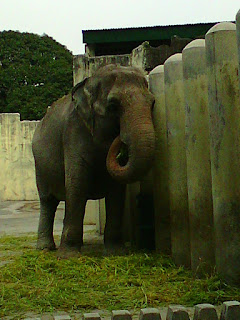OF KEEPERS AND THEIR WARDS
(Destination)
Nestor Alagbate
J216
Not having seen a place again after so many years, we wonder how much such place has changed. Sometimes we return to it not so much to see the changes but its sameness after all those years. What might have changed is our sense of attachment to the same place. Having aged gracefully, we have acquired new outlooks at old sights, new realizations about familiar places. These sentiments brought me back to Manila Zoo. It feels nostalgic that this time it was my turn to have a toddler in tow. Ages ago I was the toddler.
Though far from being a veterinarian myself, I found the park an animal lover's must-see place - in terms of what animal enclosures should not be. The sorry state of the establishment is an animal activist's very argument. For a starter, the first thing a visitor meets is a balding ostrich. Across the paved pathway is the controversial Sri Lankan elephant Mali.
Orphaned at three years old, she was transported to the Philippines in 1977. She celebrated her 40th birthday last year, as indicated in a greeting on a tarpaulin streamer.
An information board describes her as a good swimmer, yet she is enclosed by a shallow moat. Described as "highly sociable and mainly travel in groups of 5-7," she is doomed to be a solitary old spinster. She is described to "favor areas with grass, coupled with low trees and other woody plants, mainly scrub forest" Looking at her present environment, one wonders if the information board is meant as a joke.
Calls are mounting for her release to the wild, but Mayor Joseph Estrada won't let go of the park's crowd drawer (the other, a giraffe, died some nine years ago). Public Relations Bureau Director James Dechaves is "awaiting partner to be donated from Sri Lanka." Might as well pray for a miracle a la Sarah and Elizabeth of the Bible. With 250 Sri Lankan elephants killed every year, I wonder if the Sri Lankan government would permit another casualty in the remaining population of 5,879 (figure four years ago). Meanwhile the limping old lady (veterinarians call it "favoring": she avoids standing on the left forelimb, and favors the right; her hind limbs tend to lean on the left) whiles away her remaining years with sakate, banana, pineapple, and occasional carrots.
Another information board describes a hebra's (a cross between a male horse and a female zebra) habitat as "open grassland and woodland areas," yet one sees a pair of hebras on gravel and sand, maximizing the shades of practically decorative trees. The enclosure for the tiger is crammed considering their more than necessary number. The "king of the jungle" looked more like a condemned commoner in a much tighter cage - a testimony to the almost 50% population decline (figure thirty years ago) in its historic African range, of which 20% are actually occupied by the species.
As for the snakes, the glass enclosures are devoid of forest debris which could have provided warmth for the incubation of their eggs. The crocodile population far exceeds the ratio of comfortable space per head, and they have no choice but to be cramped in shallow ponds which look more like a token habitat. I wonder whether domesticated chickens and ducks on the banks of the boating area are city property or personal property of the park employees. I definitely would not pay one hundred pesos to see domesticated poultry.
Manila Zoological and Botanical Garden sprawls on a 5.5-hectare property at the corner of Quirino Avenue and Adriatico Street in Malate, Manila. Run by the city government since its establishment in 1959, it boasts of itself as the oldest zoo in Asia. Though entrance fees were hiked on January 15 last year, Director Dechaves claims the fees ares still lower than those of the main rival Malabon Zoo. For non-Manila residents, the entrance fee for adults is pegged at Php100.00, while that for children is at Php60.00. Manila residents, provided they present valid identifications, pay half the price.
Among the 106 different animal species found in the establishment, 60 are reptiles, 30 are mammals, and 13 are birds. With 15 tigers up for trade, Dechaves aims for "more variety than quantity." Though birds abound in the aviaries, looming balete and dita trees are home to non-inventoried night herons, thanks to the lagoon to which they are naturally attracted. They come in colors blue (some with white spots) and brown. Park employees observe that egrets swarm the park when there are typhoon signals. Flocks of ash-colored bato-bato also frequent the park. This species looks like a pigeon, only smaller. Though signages remind visitors to refrain from littering, there are no warning signs pertinent to droppings from birds outside the aviaries.
Approaching the exit of the park, I realized that more than what kinds of animals I saw in there, I saw what kind of humans we are in seeking amusement at the expense of other creatures.
By the way, don't forget to drop by the souvenir shops. You might be interested to buy slingshots there.















Walang komento:
Mag-post ng isang Komento